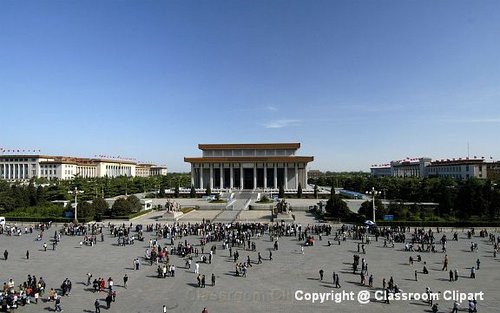Tiananmen Square
|
|
Tian'anmen Square is a very large plaza near the center of Beijing, China, named for the Tiananmen (literally, Gate of Heavenly Peace) which sits to its north, separating it from the Forbidden City. It is seen by many as the symbolic heart of the Chinese Nation. Outside of China, the square is best known for the Tiananmen Square protests of 1989.
| Contents |
Background
Built in 1417, the square is 880 metres south to north and 500 metres east to west. This gives it an area of 440,000 square metres. In 1651 (early Qing), the gate was renovated and renamed to its present form. During the Ming and Qing eras, there was no public square at Tiananmen, and instead the area was filled with offices for imperial ministries. These were badly damaged during the Boxer Rebellion and the area was cleared to produce the beginning of Tiananmen Square.
Features
Enlarged in 1949 to the current size, its flatness is broken only by the 38 metre high Monument to the People's Heroes and the Mausoleum of Mao Zedong. The square lies between two ancient, massive gates: the Tian'anmen to the north and the Qianmen (Template:Zh-cpl) to the south. Along the west side of the Square is the Great Hall of the People. Along the east side is the National Museum of Chinese History. Chang'an Avenue, which is used for parades, lies between the Tian'anmen and the Square. Trees line the east and west edges of the Square, but the square itself is open, with neither trees nor benches.
The Square is lit with huge lamposts which also sport video cameras. It is heavily monitored by uniformed and plainclothes policemen.
Events
Tiananmen Square has been the site of a number of political events such as the proclamation of the People's Republic of China by Mao Zedong in October 1, 1949 and for mass rallies during the Cultural Revolution. It has also been the site of a number of protest movements, most notably the May Fourth Movement of 1919 for science and democracy, protests in 1976 after the death of Zhou Enlai, and the Tiananmen Square protests of 1989.
The protests of 1989 resulted in the killing of Chinese protestors in the streets to the west of the square and adjacent areas. Some sources (Graham Earnshaw (http://www.earnshaw.com/memoirs/content.cfm?ID=16) and Columbia Journal Review (http://archives.cjr.org/year/98/5/tiananmen.asp)) claim that none died on the square itself. Opponents of the Chinese democracy movement object to the Western Media's labelling of the Tiananmen Massacre, the event known to the Chinese simply as the 6-4.
Images from near and in the square
See also
External links
- Tiananmen Square in 360? (http://www.thebeijingguide.com/tiananmen_square/index.html)
- National Museum of Chinese History (http://www.nmch.gov.cn/)
- Tiananmen Square Introduction and Pictures (http://www.beijingservice.com/tiananmensquare.htm)


